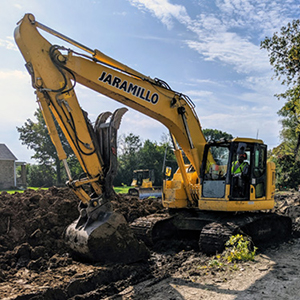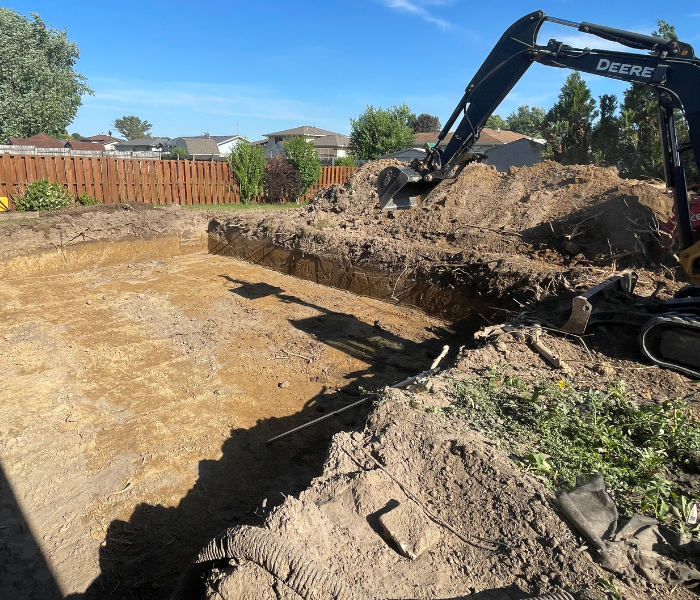Lancaster Excavation - Specialist Excavation Solutions in Lancaster, OH
Lancaster Excavation - Specialist Excavation Solutions in Lancaster, OH
Blog Article
Thorough Expedition: The Scientific Research Behind Superior Excavation Practices
The realm of excavation methods is a domain name where scientific research intertwines with workmanship to uncover the enigmas hidden beneath the earth's surface area. From old hand devices to contemporary hydraulic excavators, the advancement of excavation techniques has actually been a testimony to human resourcefulness and technical advancements. What genuinely establishes remarkable excavation techniques apart is a deep understanding of geological concepts, combined with the usage of innovative tools and methodologies. By exploring the science behind these methods, we can discover the secrets that lie below our feet and appreciate the accuracy and competence that go into every dig.
Development of Excavation Techniques
Throughout background, the development of excavation techniques has played an essential role in advancing building and construction methods and archaeological discoveries. From the rudimentary devices utilized by our ancestors to the innovative equipment employed in modern times, the development of excavation techniques has dramatically changed exactly how we approach numerous jobs.
In old times, manual work with basic devices such as pickaxes, wheelbarrows, and shovels was the primary technique of excavation. This labor-intensive process restricted the depth and extent of excavations, typically causing slow progression and limited accessibility to specific websites. However, as people progressed, so did the devices and methods made use of for excavation.
The Industrial Revolution marked a transforming factor in excavation experiment the introduction of steam-powered equipment. This innovation transformed the field, permitting for faster and more substantial excavations. In modern times, modern technology plays a critical function in excavation, with innovations like GPS systems, drones, and 3D scanning enhancing precision and effectiveness in the area. The advancement of excavation strategies remains to shape the method we construct, explore, and comprehend the world around us.
Function of Innovation in Excavation

The assimilation of cutting-edge modern technology has actually essentially transformed the field of excavation, boosting accuracy and efficiency to unprecedented degrees. One of the key technical improvements that has significantly influenced excavation methods is the utilization of general practitioner systems. These systems enable for accurate mapping of excavation websites, allowing operators to properly locate below ground energies and structures. In addition, making use of telematics in excavation equipment has actually enabled real-time surveillance of maker performance, causing proactive maintenance and raised functional efficiency.
In addition, the arrival of 3D modeling and simulation software application has streamlined the preparation process for excavation tasks. Operators and designers can now visualize the entire excavation procedure prior to breaking ground, maximizing and determining potential difficulties process. In combination with this, the implementation of drones in excavation activities has actually facilitated aerial studies, volumetric measurements, and site examinations with unrivaled speed and precision.
Geological Concepts in Excavation
An understanding of geological principles is crucial visit their website for ensuring the architectural honesty and stability of excavation sites. Geological factors play a vital duty in establishing the usefulness and security of excavation tasks.
By carrying out extensive geological surveys and evaluation, excavators and designers can develop approaches to reduce threats and ensure the successful conclusion of excavation tasks. Ultimately, integrating geological principles into excavation methods is crucial for accomplishing safe, efficient, and lasting outcomes.

Newest Tools for Excavation
In the realm of excavation techniques, modern innovations in devices have actually revolutionized the efficiency and precision of excavation processes. One of the current tools making waves in the industry is the use of drones equipped with advanced imaging technology. These drones can provide comprehensive airborne studies of excavation websites, using real-time data on topography and potential risks. This info aids in far better planning and decision-making during the excavation procedure.
One more cutting-edge tool obtaining popularity is the execution of 3D printing innovation for creating personalized excavation devices. This allows for the manufacturing of specialized tools that are customized to the particular needs of a job, increasing performance and decreasing downtime.
Furthermore, improvements in materials scientific research have caused the development of more powerful and much more durable excavation tools. septic ohio. Tungsten carbide-tipped excavator accessories, for instance, deal superior performance in tough ground conditions, enhancing efficiency on-site
Scientific research's Influence on Excavation Practices

Additionally, scientific research study on dirt mechanics and geotechnical engineering has actually provided important understandings right into dirt behavior, enabling excavation experts to make check here enlightened decisions concerning excavation techniques and dirt stablizing strategies. Overall, science continues to drive advancement and renovation in excavation techniques, making excavation tasks more efficient, affordable, and sustainable.

Conclusion
In verdict, the advancement of excavation methods has been significantly affected by innovations in modern technology and a deeper understanding of geological principles. The latest tools and tools utilized in excavation have boosted effectiveness and precision in the area. The application of clinical knowledge has actually dramatically improved excavation advice practices, resulting in more sustainable and reliable techniques for excavating numerous kinds of materials.
In the world of excavation practices, modern technologies in devices have actually transformed the effectiveness and precision of excavation procedures. By leveraging clinical concepts, the excavation market has been able to significantly improve performance, precision, and safety and security in excavation procedures. GPR enables excavation teams to non-invasively check and map subsurface structures, energies, and prospective risks, enabling them to intend excavation jobs with higher accuracy and lowered danger of accidents.
In addition, scientific research study on dirt auto mechanics and geotechnical engineering has actually offered valuable understandings into dirt habits, allowing excavation specialists to make informed choices relating to excavation methods and dirt stabilization strategies. In general, scientific research continues to drive innovation and enhancement in excavation practices, making excavation jobs more effective, affordable, and lasting.
Report this page